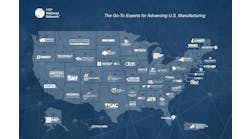Cumulative Regulatory Burden Is Harming Manufacturing Competitiveness
Federal regulations are having a cumulative economic impact far in excess of their individual costs and are threating the competitiveness of U.S. manufacturing, NERA Economic Consulting warns in a new study commissioned by Manufacturers Alliance for Productivity and Innovation (MAPI).
In "Macroeconomic Impacts of Federal Regulation of the Manufacturing Sector," NERA looked at the cumulative impact of federal regulations issued since 1981 that affect the general economy and the manufacturing sector in particular. The study found 2,183 regulations affecting manufacturing, of which 235 are considered "major" regulations with compliance costs of $100 million or more.
The NERA study estimates that these regulations cost the economy from $265 billion to $726 billion a year in direct compliance costs.
Over the next decade, NERA finds, regulations could reduce output by up to 6%, or from $200 billion to $500 billion. The study found that manufacturing exports in 2012 could be 6.5% to 17% lower than they would be without the regulations.
MAPI President and CEO Stephen Gold told a press conference that 90% of regulations affecting manufacturing are considered "non-major" and their costs are not tracked by the federal government, but that the cost of these regulations "may be comparable" to the costs of the major regulations. All these rules interact, he said, and create an economic burden much greater than the sum of the individual rules. For a country struggling to create economic growth and increase employment, Gold said, the current regulatory system amounts to "shooting yourself in the foot."
The study found that the pace of regulations was picking up. During the Clinton Administration, the federal government issued an average of 36 major regulations annually. In the Bush administration following it, the number of major regulations issued each year averaged 45. But during the Obama administration, that number has grown to 72.
EPA Has Most Impact on Manufacturers
NERA points out that the largest number of regulations imposed on manufacturers were issued by the Environmental Protection Agency (972 total regulations, including 122 major rules), followed by the Department of Transportation (880 total regulations, including 69 major regulations), the Labor Department (214 regulations in total, including 27 major regulations) and the Energy Department (106 total regulations, including 17 major regulations).
The machinery and transportation equipment industry (NAICS 33) was impacted by the most regulations - 185 regulations and 1,423 non-major regulations. Businesses involved in wood, paper, printing, petroleum products, chemicals and plastics (NAICS 32) were subject to 65 major regulations and 755 non-major regulations. Food, beverage and textile manufacturing (NAICS 31) were impacted by 41 major regulations and 375 non-major regulations.
W. David Montgomery, a senior vice president at NERA Economic Consulting, emphasized that because the costs of regulations such as those issued by the Securities and Exchange Commission are not tracked, even the upper end of NERA's estimate is an "underestimate" of the regulatory cost burden.
NAM President and CEO Jay Timmons, who also participated in the press conference, noted that the increase in regulatory activity has occurred no matter "which party is in the White House." While President Obama had issued an executive order to streamline outdated or burdensome regulations, Timmons said, the effort, like that of previous administrations, had not "significantly restrained regulations."
Timmons warned that new proposed regulations, such as EPA's boiler MACT rules that could cost more than $14 billion, and the agency's utility MACT rule that could shut power plants and drive up energy costs for manufacturers, would add to the competitive burden U.S. manufacturers face. He noted a previous MAPI study which found that U.S. manufacturers faced 20% higher structural costs than their competitors in other major manufacturing nations.
Timmons said the U.S. needs to develop a new regulatory system where the government and industry act in "partnership," rather than as adversaries, in order to improve the nation's competitiveness.



